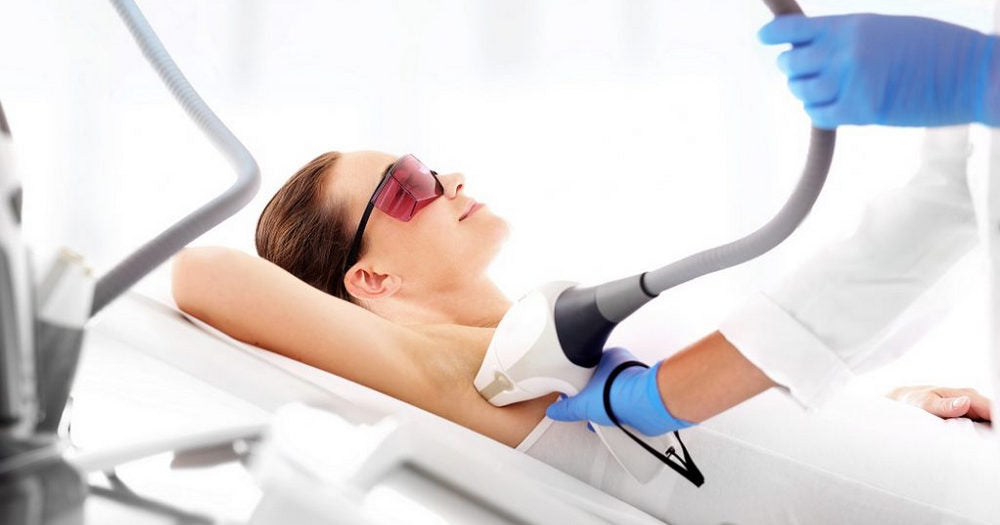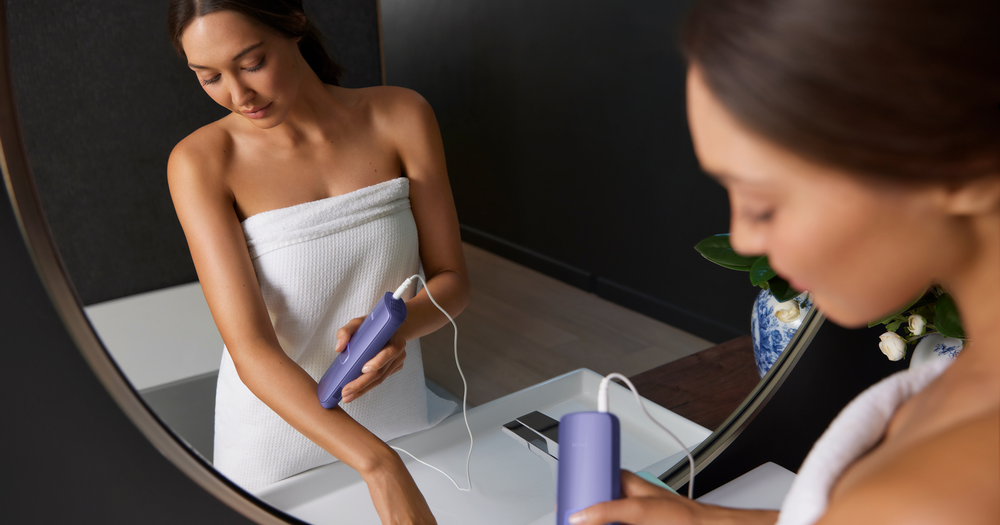Laser hair removal saves you the hassle of removing unwanted hair every day and the frustration of having dull hairs sticking out of your skin and making it look rough. A few years of hair-free skin is worth the expensive treatment. But there's more to laser hair removal than the price you pay for it.
The laser uses a very intense beam of light and sometimes there are not many safety mechanisms to protect the skin, which leads to side effects from the laser. Although most side effects such as redness and irritation subside on their own after a while, some rare but serious side effects such as burns require special attention.

In this article, we'll talk about laser burns so you can treat them if you have them, how to avoid them in the future, or how to prevent them from happening in the first place.
Table of contents:- Part 1: What are laser hair removal burns and how do you get them?
- Part 2: Signs and symptoms of laser burns
- Part 3: Treating burns from laser hair removal
- Part 4: Ways to avoid burns during laser hair removal
- Part 5: Conclusion
What are laser hair removal burns and how do you get them?
Laser burns are overheating and burns of the epidermis caused by the high-intensity radiation of the laser device. They are not common because experienced doctors take the necessary precautions, keep their equipment in top condition and educate patients in detail about the dos and don'ts of the laser.

However, you will end up with severe side effects from the laser if your skin tone is too tanned for the laser, your laser surgeon is not skilled, the gel before the laser is not used properly, hygiene is not maintained, or the manual of laser hair removal is not followed sufficiently. In these cases, laser hair removal can take some have side effects and risks .
Signs and symptoms of laser burns
The clinical features of laser hair removal burns can range from mild to severe. Depending on the severity of the burns, you will need to treat them. So let's first find out what characteristics laser burns have.
-
Redness and irritation
Redness is the mildest form of laser burn and is not even considered a side effect. It may be accompanied by irritation. Both will go away on their own. In addition, all types of laser burns are associated with pain.

-
Swelling and blistering of the skin
If the intensity of the laser is too high when your skin is sensitive or you have tanned skin, the redness can lead to swelling of the skin that takes the shape of the laser device and you may also get blisters.
-
Crust formation and discoloration of the skin
The blisters crust over and eventually peel off. In addition, the burns leave their marks and cause discoloration of the skin that is difficult to treat.
Treatment of burns from laser hair removal
-
Wash with plenty of water at room temperature
The first thing we should do in any type of burn is to neutralize the heat by washing the area with plenty of water. So let water run over the burning skin until you no longer feel any painful or burning sensation.
Also remember that you should use slightly cool or room temperature water and never cold water. This is because cold water delays healing and the skin should only be washed to prevent the burn from progressing.
-
Keep the area cool
Once the pain is gone, it's time to reduce or prevent inflammation. So avoid being in a hot environment. Keep your room temperature cool and apply a cool compress to the burned area for about half an hour.

-
Bandage the burned area
The next step is to protect the burned area with the blisters or crusted skin from infection and friction. To do this, use a soft gauze bandage or a thin plastic wrap. However, the timing of this step depends on the severity of your burn.
Don't wrap the gauze or foil too tightly around the burn. Keep it as gentle and loose as possible. Covering the area will also prevent you from touching or scratching it.
-
Treatment of pain
One thing you will feel with all types of laser burns is pain. It can be tolerable or too much to bear, so take a systemic painkiller once you have washed the burn. You can use acetaminophen, naproxen sodium, or ibuprofen to help ease the pain.
-
Prevention of infections
Burnt skin is susceptible to infection. One way to prevent this is to cover the area, but this is not always enough if your burn is too severe. So use an antimicrobial ointment to prevent bacteria, viruses or other microbes from entering the skin.
Ointments are also helpful if you are not wearing a bandage at first so that the heat can escape from the skin.
-
Avoid sunlight and tight clothing
Sunlight is your worst enemy when preparing for, undergoing, after or even when you get laser burns. The sun's heat and UV rays trigger the pain and prevent healing, so stay indoors, wear UV-protective clothing and use sunscreen when possible.
Additionally, the friction of clothing can irritate or peel the skin in the burned area. Therefore, wear loose clothing that does not come into contact with your skin. This also allows your skin to breathe better.
-
Use gentle skin care products
You should avoid using products with harsh chemicals or active ingredients until your burn has recovered, so avoid using retinol, AHAs, BHAs, and similar products.

Also, do not use thick or oily products as they will trap heat and prevent the burn from healing. The burn may take 2 to 4 weeks to heal and full recovery will take longer, so it is important to consult a dermatologist before using any skin care or makeup product.
-
Treatment to relieve burns and promote healing
Soothing skin care products like aloe vera gel are best to use while your burn is healing. It cools the skin, stimulates cell regeneration, and prevents scarring.
Additionally, Vaseline or other petrolatum active ingredients work wonders to promote healing of the skin's surface. Other natural products like rose water can also be helpful.
-
Go to your doctor
First-degree burns and minor second-degree burns can be treated at home as long as you follow the treatment protocol. Severe second-degree burns and third-degree burns need special attention.
So if you have a severe burn while you are in the hospital, get it treated by a doctor immediately. Or if you are not treated by a doctor, go to a nearby hospital immediately and get it treated.
You should also see a dermatologist if you notice that your burn does not respond to home remedies.
Ways to avoid burns during laser hair removal
Treating burns can be a problem, but preventing them isn't a big deal. All you need to do is follow these precautions.
-
Choose a professional laser hair removal clinic
Do your research before you decide to have laser hair removal. Don't go for cheap offers or unknown laser salons. Instead, check the reviews, the qualifications of the laser surgeon, the registration of the clinic, the condition of the equipment and the license of the laser technicians.

-
Talk to your doctor in detail
Most good laser hair removal salons offer a free initial consultation, so take your time to talk to your doctor about your expectations, the laser procedure, aftercare, and more.
Also, discuss the different types of lasers with your doctor and choose the right one for you. You can familiarize yourself with different types of lasers by reading the Types of laser hair removal devices .
-
Prepare your skin for the laser
You can't just have a laser session at any time. You have to prepare your skin for laser hair removal. For example, the laser cannot be used on waxed skin. So you have to shave your hair and trim it to the recommended length.
In addition, your skin must be exfoliated beforehand and must not have any skin care products on it. You can also read here, how to prepare your skin for laser removal .
-
Follow the precautions before lasering
In addition to preparing your skin for laser treatment, there are some precautions you should take to avoid the side effects of the laser. These include using and reapplying sunscreen regularly, avoiding sun exposure, stopping the use of harsh skin care products, and avoiding tanning of the skin.
These precautions should be taken at least 15 days before your laser hair removal. You can also ask your doctor to explain all the necessary requirements for laser treatment.
-
Never forget the aftercare
Aftercare for laser hair removal is just as important as skin preparation and precautions. The most important components of laser aftercare are moisturizing the skin, avoiding sun exposure, avoiding hot showers, pausing the use of skin care products, wearing loose clothing and using cold compresses.
But the good thing is that you only have to follow it for 24 to 48 hours after laser treatment, so you can carry on with your normal routine afterward. Since laser hair removal requires multiple sessions, you should shave your skin between sessions and not use any other method of hair removal.
Conclusion
Laser hair removal can cause skin burns if standard laser procedure is not followed and can also cause long-term after-effects.
So if you ever get laser burns, you can treat them yourself with cooling treatments, painkillers, antibiotics, healing ointments, and soothing skin care. However, if the burn is severe, you must see a doctor.





























